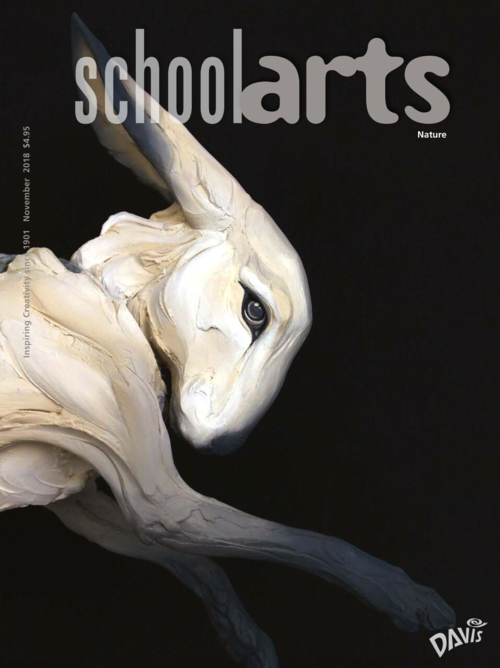We use our art garden year-round, and it grows along with us, with each season bringing new surprises and a changing landscape.
As we head back to school in August, we relish in the summer’s final blooms—pink coneflower, orange trumpet vine, and yellow heliopsis daisies. These warm-colored flowers ease the transition from the heat of summer into the coming fall, when we start our first sketches of the year.
The Garden Sketchbook
Students keep a sketchbook throughout the year that they use for garden drawings. When they take their spiral-bound pages outside and into the garden for the first time, I present them with the following expectations: (1) Enter nature calmly. (2) Boldly draw what you see. (3) Respect each student-artists’ space. After initial sketching, students add brilliant color with water-soluble crayons, focusing on value and unity. The students practice this routine throughout the school year.
Fall
As petals fall to the ground and colors change to deep reds, we commemorate with watercolor paintings. Students begin with light sketches and move into plein-air painting as they freely observe the richness of our surroundings, equipped with drawing boards made from recycled cardboard bordered with masking tape.
 Gabe Smith, garden drawing, grade eight.
Gabe Smith, garden drawing, grade eight.
We also read Leaf Man by Lois Ehlert, a beautifully illustrated book that uses a variety of collaged leaves to tell the tale of Leaf Man and his surroundings. Students gather their own collection of leaves and collaboratively make leaf critters and habitats from their bounty of leaf loot. Finally, fall would not be complete without leaf rubbings and watercolor resists.
Winter
In the stillness of winter, I use the barren trees to teach line and charcoal drawing. We focus on form and composition as we draw our trees with overlapping branches fully in sight. Winter also lends itself well to black-and-white photography. On one cold day, we caught our garden stunningly encased in ice and excitedly grabbed cameras and iPads to document the rare splendor.
Spring
Daffodils bring the first sign of spring and the promise of warmer weather. The excitement of these early bloomers is a great time to incorporate artworks of impressionist and post-impressionist painters such as Monet and van Gogh. Once students finalize their compositions, they create vibrant works on canvas with acrylic paint.
With signs of new life all around us, I partner with our science teacher on a plant anatomy unit. While students explore the intricacies of plant parts and their function in science class, their focus in the artroom is to visually represent plants from different perspectives. Their drawings are later turned into ceramic flowers, built on a 5 x 5" (13 x 13 cm) base and glazed to perfection. In another favorite spring activity, inspired by the environmental artworks of Andy Goldsworthy, students create flower mandalas using petals, leaves, pine straw, acorns, rocks, and sticks.
As we use our sketchbooks for the final time before breaking for summer, students reflect on the series of drawings they have created throughout the year.
Summer
The beauty of our garden does not go unnoticed during the summer months, as our campus is used for summer camps. This is a time for hammered flower pigment transfers, nature prints using sun-sensitive photo paper, and large oil pastel flowers inspired by the artworks of Georgia O’Keeffe.
.png) Gabe Klein, grade six, observes and sketches the garden.
Gabe Klein, grade six, observes and sketches the garden.
Want to Start Your Own Art Garden?
An outdoor garden can enrich an already vibrant curriculum. You can use an open space on your school’s campus or terracotta pots as space permits. When possible, use native perennials; they have adapted to local environmental conditions, are easier to care for, use less water, and will last for years. A garden can also serve as a place for community involvement. Parents, students, and faculty can all add to the space and watch their additions grow with each emerging season. However the space is created, make it a source of inspiration for you and your students.
Amy McGlinn is an art teacher at the Friends School of Wilmington, in Wilmington, North Carolina. amym@fsow.org
NATIONAL STANDARD
Connecting: Relating artistic ideas and work with personal meaning and external context.
WEB LINK
www.friendsschoolart.blogspot.com
View this article in the digital edition.


 Gabe Smith, garden drawing, grade eight.
Gabe Smith, garden drawing, grade eight..png) Gabe Klein, grade six, observes and sketches the garden.
Gabe Klein, grade six, observes and sketches the garden.